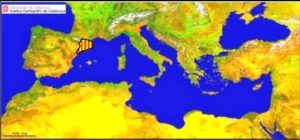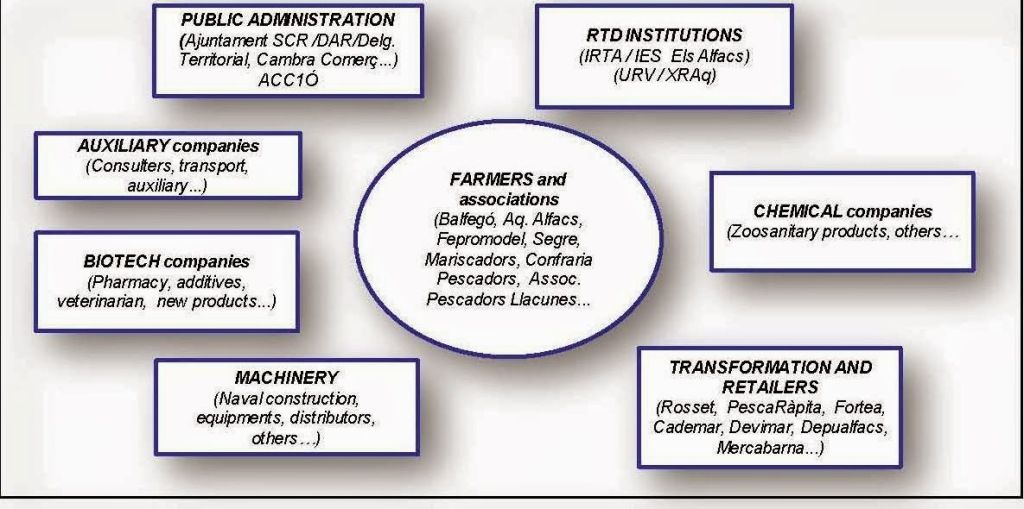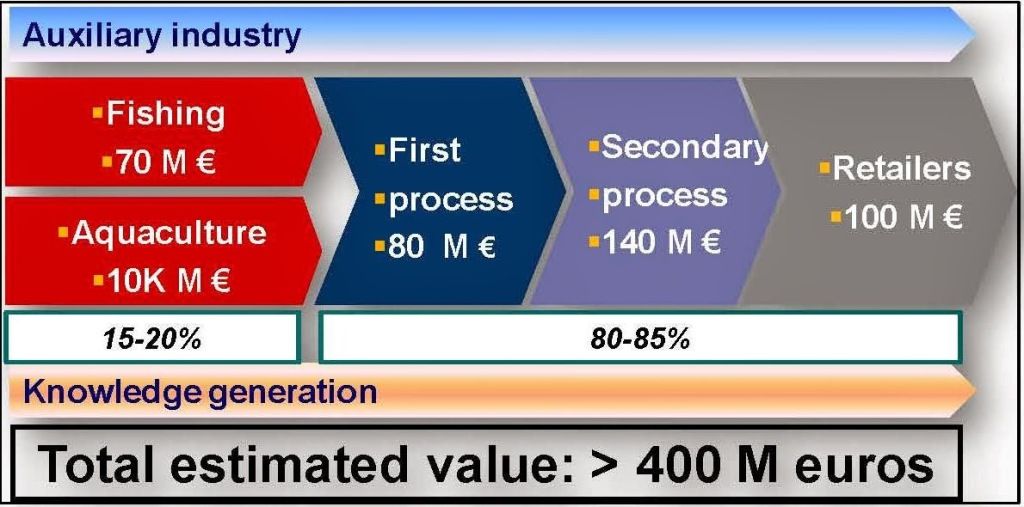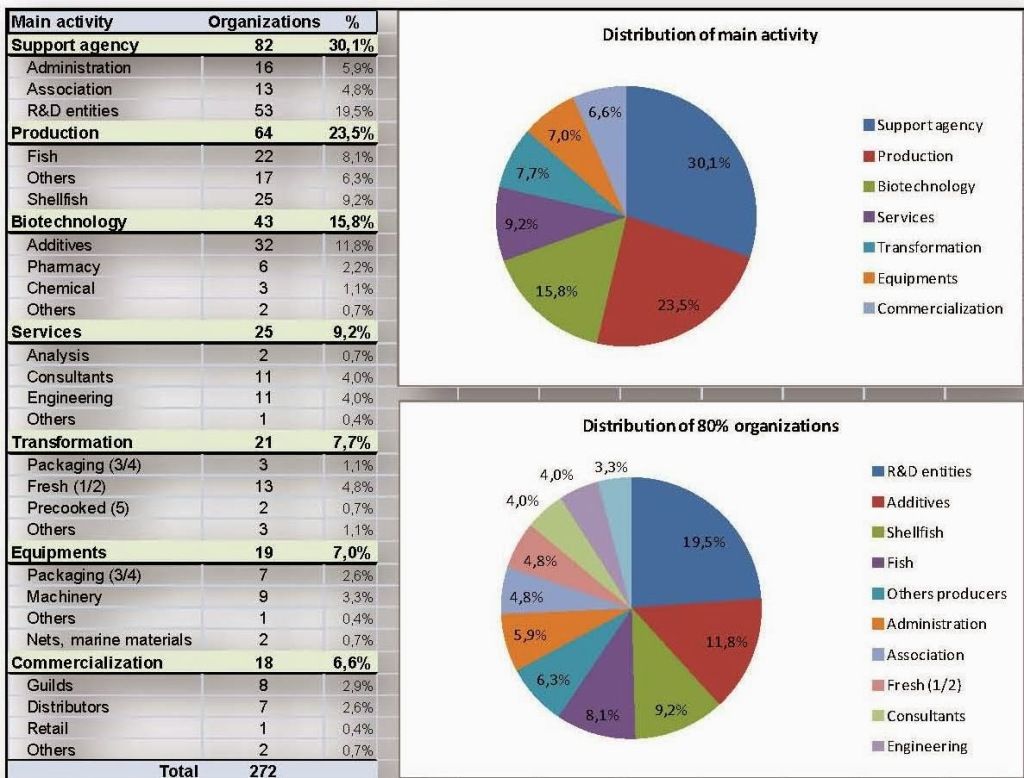Catalonia has all the elements embodied in Professor Michael Porter’s strategic management system (Porter, 1990) that can be considered essential and necessary for establishing a successful aquaculture cluster. Starting from the assumption that there are no good or bad sectors, but instead strategies that are more or less adequate depending on the current situation (Hernández, 2012), we can redefine this successful model for our own purposes as the 6Cs: characteristics, capacities, competition, companies, customers and capital.
In 2010, aquaculture generated almost 50% of the world production of edible fish destined for consumption (FAO, 2010), and it is estimated that by 2030 this figure should increase to account for 65% of all aquatic-derived food. Recent FAO estimates suggest that world food production will increase by 70% until 2050 in order to support the growth in the world population and demand for quality protein (APROMAR, 2011), which will be approximately 73 million tonnes (total value of 88,000 million €), compared to 89 million tonnes that come from the total fish catch.
To delve into the importance of aquaculture, we only have to look back to June 2012 and the AquaVision conference (http://aquavision.org) which is: “…the biennial international aquaculture and food business conference organized to provide a platform and network for discussion at a strategic level on current and future concerns from consumption and marketing back to farming, fish processing and feeding.” At this conference, Kofi Annan acknowledged the potential of aquaculture for contributing to sustainable food production, especially when we face the challenge of feeding 9 billion people by 2050.
Moreover, the European Aquaculture Technology and Innovation Platform (EATIP) has recently published on-line (http://tinyurl.com/EATiPVision) a document representing its vision of the future for European aquaculture, which will be presented formally on 30th October 2012 in Brussels. In fact, it is worth considering certain data presented in this report about what European aquaculture represents: 190,000 directly and indirectly related jobs, 7 billion € in production value, more than 1.9 million tonnes of marine and freshwater fish, 650,000 tonnes of shellfish and 2.7 million tonnes of feed. Consequently, there is a need to pay attention to such a serious and important activity, and decide that we can no longer ignore what aquaculture contributes or, more importantly, what it should contribute and provide in the future.
 Catalonia in context
Catalonia in context
Catalonia (picture 1) has 450 km of coastline for practicing marine aquaculture, and rivers and natural areas for freshwater continental aquaculture. In recent years, a strategic study has been undertaken of the most suitable zones where aquaculture could be practiced and this has identified 23 ideal areas along the coast. Since the early 1980s, several different activities related to aquaculture practices have been developed, including various technologies such as open water culture using off-shore cages, shore-based facilities using recirculation (RAS) and open circuit, both intensive and extensive, farms producing high-value animals and rafts that are highly integrated into the environment in the southern part of the region. Varied species are produced, such as fish (seabass, seabream, maigre, eels, trout, sturgeon and tench) and shellfish (clams, oysters and, especially, mussels), and this activity occurs from north to south and from east to west, which has led to Catalonia actually becoming a spearhead in the Mediterranean for what has been a new emerging activity since the mid-1990s because so many of the appropriate characteristics necessary for aquaculture are available in the area.
Catalonia has consultants, engineers and support services, and a strong agrofood industry that is especially important in areas such as health, welfare and animal nutrition, as well as food technology. It has a network (http://www.xraq.cat) of some of best institutes and research centres in the Mediterranean area, who are leaders in scientific production and technology transfer, as well as having leading universities that offer master’s degrees in aquaculture (e.g. http://www.ub.edu/masteroficial/aquicultura).
There is also an administration committed to the idea of driving such initiatives and generating the right environment for these policies to be successful. Therefore, there is no question of our capacities and competitive spirit for developing aquaculture as a strategy for growth and business diversification (picture 2).
In Catalonia, there is a substantial group of companies whose principal activity is the growth and fattening of aquatic animals, mainly bivalves and fish, and, as mentioned earlier, it has a powerful network of biotechnology companies related to nutrition, as well as animal health and welfare, with a clear commitment to increase its presence in the aquaculture industry. They believe that the sector has a real possibility for increasing its turnover, since it is considered without doubt that aquaculture is part of the present and should be an essential part of the future. There is also an extensive network of processors and distributors with a presence in major national and international markets (companies).
Catalonia has a potential market of at least 7 million inhabitants who consume an average of 35 kg per capita of seafood products a year (customers), a huge cultural gastronomy associated with marine food products, and major advocates (renowned chefs) with media exposure that enables them to exhibit their skills at a world level. Therefore, there is a sufficient driving force from the economic point of view to attract investors and promote the emergence of new businesses related to the activity, as shown by the fact that a considerable number of companies have already shown interest in the creation of the aquaculture cluster (capital) (picture 3).
The choice of model
Seen in perspective, there is everything necessary for the creation of an aquaculture cluster. However, in the process of dynamization and the conception of the current cluster, it has been learnt that the policies of competitive change, based on a thorough analysis of the strengths behind the original primary elements postulated by Porter (Porter, 1990), which basically make up the structural business model, do not work without the main driving force of the one priority area that has to be based on the model itself, which, in our case, is the primary producer. Regardless of the size of this sector, it was found that when this nucleus was not perfectly represented within the very essence of the cluster, the whole process was condemned to failure, since the internal elements that unite the model pivot on its existence.
In order to structure the cluster properly, a creative process had to be employed that was similar to the one used in assisted fertilization when the process of natural reproduction is not possible, for whatever reasons the parents might have. In the end, the objective is the same, to obtain viable offspring (i.e. a useful living cluster that can generate wealth) using part of our hereditary genetic makeup (a correctly applied clustering policy that has been used for years in Catalonia) and, if possible, to improve them over time (new models of interaction with innovation as a catalyst), which is how we managed to lay the foundations for clustering through a process similar to artificial insemination.
For reproduction to be successful, courtship is required, and at least a temporary, intense and almost animal infatuation that promotes the chemistry of the relationship. This process of the creation/infatuation of a cluster is actually not described anywhere but it is absolutely essential that we are able to define the final objective with detail and accuracy, and invest so much energy (in the form of human and financial resources) in something as ethereal as the implementation of policies based on innovation as a driver of improved competitiveness, where the real challenge is to make innovation go from being a buzzword to being a widely distributed concept and part of the DNA of the organizations involved, much like any other of their capabilities. It is not enough to be a colourful peacock; we must be the one that sings best and shows off its plumage better, in order to ensure success and transmission of the core DNA needed to create a living entity.
Our own courtship process started by striding out and producing a strategic positioning report for the sector that indicated Catalonia had all the elements to ensure success and find business support, as well as having a supportive public administration that openly said the project was very interesting. In addition, we also took into account that, without doubt, we were in one of the best places in the world with wide-ranging experience in many associated areas, and that Catalonia has been a model for inspiring the clustering policy. In fact, there are already about 30 active, successful clusters (Martí, 2010 & 2013) and, therefore, there was no reason not to create our own because we were already active, and there were small and medium enterprises familiar with developing forward-looking projects of this type.
The errors of the process
After a selection process, we chose those we considered would become true leaders and drivers in the cluster when the time came, and so we prepared the presentation of our idea and went to explain what we wanted and what we proposed to do. However, we realised immediately that we did not know how to get the idea across sufficiently, because those who were potentially interested did not understand the concept. Nevertheless, although something was initially wrong, the effort we put in during the early stages was the best tool for learning quickly, since the original approach led us to make our first mistake, pretentiousness. As a result, we realised it was better for the participants to explain to us what they were capable of doing and what they wanted, and in return that we understood their position and how they saw future developments. However, after a preliminary but very comprehensive analysis, to have a catalogue of more than 250 organizations (picture 4) that could not only be part of the cluster but had to understand that it was made to measure, or at least we thought so, led us to assume from the beginning that it was easy to launch a conventional cluster model.
After another round of interviews in which this time we asked rather than explained, we concluded that it was necessary to adapt and redesign our original model, which was essentially still valid, because it was necessary to adjust it more closely to the characteristics of the sector. Therefore, we organized technical seminars with invited experts in order to help strategically position the companies involved, since it was understood that they required additional specific studies, some as clear as roadmaps, seminars, meetings, ad hoc visits, connections with other complementary clusters, trips to study benchmarking, creating knowledge environments, social life, media stimulus, etc. This was all carried out as perfectly as possible, but we still did not manage to consolidate the model, and it was realised that the reason was because we had gone from being pretentious to being excessively respectful. Consequently, we made the second mistake, the underestimation of our abilities. In other words, direct steps must be taken to show those involved what their potential is and that immobility is the worst of all possible alternatives, we must generate discussion through dialogue, appreciate that the effort is useful and that the strength of the participants, particularly the natural leaders, is so powerful that nothing can stop them.
We actually began the process of selecting an individual as the motor and the company as the bodywork, but we realised that not everyone fits into the same towing vehicle, and this led to the third mistake that assumes everyone will travel in the same carriage.
This was followed immediately, and with almost no time to react, with the assumption that everyone was in fact represented in the cluster, but individual sensitivities led us to make the fourth error, the use of conventional communication relationships (e-mail) instead of using social networks and their potential to go beyond traditional boundaries. The power of social networks is extraordinary, but you have to make proper use of them, in the right measure, for creating value, requesting cooperation and making everyone involved in the process feel as if it were their own.
We quickly learnt and realised that the natural fertilization process that should have led to the birth of an aquaculture cluster was not going to take place. We began to suspect that all the effort had been in vain but we were not aware that each and every one of the steps taken actually forms part of an assisted fertilization process, in which we acted as experts in reproduction, saw the birth of the child, which we christened AquiCAT, and thought it was growing and growing well. However, without knowing why, we made the fifth error when we kept seeing it more like a foetus than a natural child. At this point, we had no choice but to learn from the mistakes and reinvent ourselves again. Therefore, we started a process of naturalization, and decided to present the cluster properly to society, register it in the civil register (https://www.acuiplus.org) and show that we were proud of what we had created (using a Strategic Immersion Meeting). However, more importantly, we started a process of reflection that has led us to where we are today.
Conclusion
Almost certainly, we have not had time to make any more mistakes but, after a year of activities, we consider that the achievement to implement a dynamization plan and that we have managed to mobilize the sector, which for a few moments has made us think of something a little different every day, has helped those involved question whether their models are the most adequate. In addition, the participants feel sustained, at least partially, by the internal analysis process that questions the business strategy, and they now talk about innovation amongst themselves, which is assisted by the offer of the support tools for decision making we are capable of providing for them. This is helpful not only for their future strategy but also for the present strategy and, as a result, the whole process has definitely been a qualitatively important success. We will soon know if our project is successful, we believe it will be, but whatever the outcome we have learnt a way of working that can help other similar clusters with their methodology. At least we now know which mistakes we shouldn’t make and can only hope we don’t make any more in the future.
Bibliography
- APROMAR. (2011). La acuicultura marina de peces en españa 2011. 77 pp.
- FAO (2010). The State of World Fisheries and Aquaculture 2010. FAO Fisheries and Aquaculture Department. 218 pp.
- Hernández, J.M. (1 January 2012). La estrategia correcta. La Vanguardia, p. 9.
- Martí, J. (2010). Els cluster com a eina de millora competitiva per a les empreses. Pers. Comm.
- Martí, J. (2013). Clústers. Estrategias ganadoras y trabajo en equipo. Ediciones Urano, S.A. Barcelona.
- Porter, M. (1990). The competitive advantage of nations. Free Press, MacMillan. New York. 855 pp


